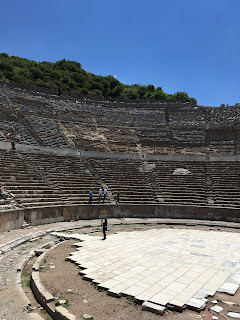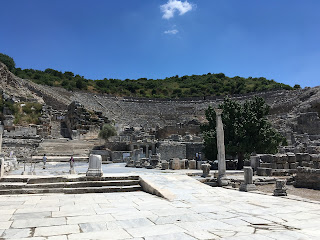First, looking back at the Agora from the entrance:
And now, the inside:
By the way, we could hear everyone inside that very clearly.
I'm just going to post every picture I have here. It won't capture how it felt to stand in the Theater, but maybe it will give you an idea.
 |
| This was from near the entrance |
Pictures from the stage!
Notice the space between the stage and the seats? The guide says that space is there because this is both a Greek and a Roman theater. It was built by the Greeks, who used theaters to put on plays; however, the Romans used theaters for more exotic spectacles, namely gladiator fights. The space is there to protect the spectators.
Notice - this is very important - that I could go past that stone block you see going between the seats. That will be important later.
 |
| I think this is from that stone wall midway up the seats |
 |
| Higher up! I was getting a little dizzy. |
 |
| I think this must have been from the top. |
 |
| I was trying so hard to take a picture that gives an idea of how big the theater is, but I don't think I managed it! |
Now, back to my comment about the stone wall, and the pictures taken from as high up as I was allowed to go. I have read and heard in multiple places (probably every book that mentions Greek theater) that the seats were so well designed that the spectators in the back seat could clearly hear and understand the actors all the way down on the stage. I don't know that I necessarily believed them - I guess I thought they were exaggerating slightly, or that they were guessing but the theaters are so decayed over time that we could never really know for sure.
Well, it's probably true. And here's my modern technology version to prove it: When I went back to the highest row I was allowed to go to, there was a guy next to me who was talking on his cell phone. I was right next to him when I took some of those highest-up pictures, and I could hear the voice of the person he was talking to. Okay, no big deal. After taking those pictures, I went back down to the stage, and I could still hear the person he was talking to!!
Once again: I could hear the person on the phone!
Seriously, go back and look up at those pictures, and look how far away the stage is from the people highest up. And remember, I could hear a phone conversation from that far away! The Greeks were truly masters of architecture!
Anyway, here's the exit (not the way we came in - the entrance we used is right on top of the exit):
And finally, what I would have seen had I been paying attention rather than staring at the Agora:
Acts 19:23-41 describes the riot of the silversmiths in Ephesus, about how they met in the Theater and shouted for hours until the city clerk calmed them down. Professor Finnigan pointed out to me that Ephesus was a city that Rome allowed free governance, but that allowing for riots might lose them that status; she also mentioned that it might not have been a riot in the way modern sensibilities think of it, but rather that the term riot was used to apply to any unlawful gathering. Nonetheless, I'd be willing to bet that any angry disturbance in that theater must have been downright terrifying. It goes to show the faith of the two Christians who were dragged into the theater that they were willing to stand strong in spite of what must have been a terrifying experience. It's far from the best example of Christian fortitude in the New Testament, but looking back on it now, being in that theater might be the closest I have ever come to seeing truly violent persecution - and, God willing, it will be the closest I and all I love will ever come. I do not know what I would do if I were the target of an angry mob.
So, in summary, the theater was awesome and could easily be terrifying. It alone was worth the trip to Turkey, so if any of you get the chance to visit Ephesus, I recommend grabbing it with both hands. The Theater, and the city itself for that matter, are absolutely awe-inspiring.















No comments:
Post a Comment